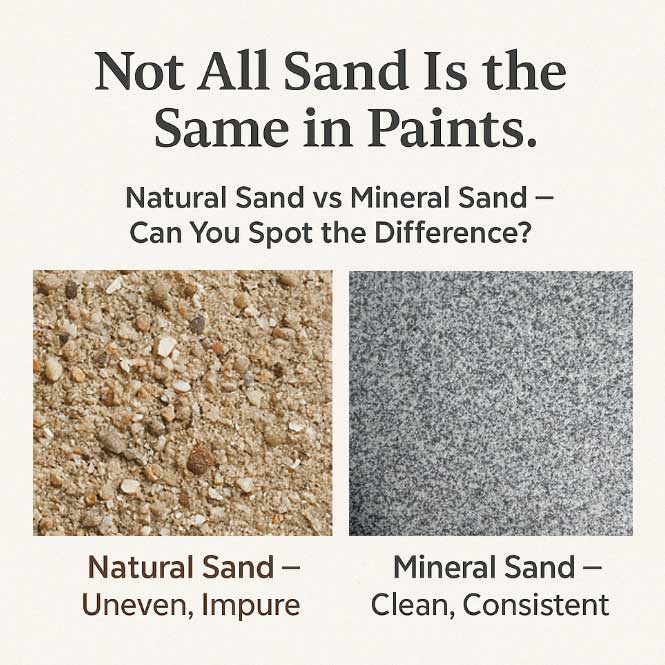The Material Upgrade Behind High-Performance Architectural Coatings
Why Vissney Insists on Using Selected Mineral Sand
In modern architectural coatings, the quality of fillers and aggregates plays a decisive role in determining the coating’s texture, durability, and overall performance. Among these, sand-based materials are critical components used in both interior and exterior wall coatings. Two primary types of sand are commonly used in the market: Natural Sand and Mineral Sand. While both serve as foundational ingredients, they differ significantly in terms of consistency, durability, and environmental compatibility.
1. Material Source & Processing
Category | Natural Sand | Mineral Sand |
Source | River sand, mountain sand, sea sand | Crushed and purified mineral rocks (quartz, feldspar, mica) |
Processing | Basic screening and washing | Crushing, calcination, classification, impurity removal |
Purity Control | Inconsistent, impurity-prone | Highly controllable and consistent |

2. Performance Comparison
a. Grain Size & Texture Uniformity
Natural Sand: Irregular grain size and shape often result in inconsistent coating finishes.
Mineral Sand: Precision-controlled particle sizes and structured shapes provide smoother and more uniform textures.
✅ Vissney’s artistic coating collections are made with selected mineral sand to ensure visual consistency and refined texture, ideal for premium residential and commercial projects.
b. Environmental Compliance
Natural Sand: May contain salt, clay, or other impurities, with limited traceability and poor eco-credentials.
Mineral Sand: Engineered for purity and processed to comply with international environmental regulations such as REACH and ROHS.
✅ Vissney’s export products are formulated with mineral sand that meets strict environmental and health standards, making them suitable for LEED-compliant and eco-conscious construction.
c. Alkali Resistance & Durability
Natural Sand: Prone to efflorescence, discoloration, and degradation over time.
Mineral Sand: Naturally alkali-resistant and weatherproof—ideal for humid, coastal, or tropical environments.
✅ Vissney’s exterior coating systems leverage mineral sand for superior anti-stain, anti-fungal, and weathering performance across long-term projects.
d. Color Stability
Natural Sand: Color variation due to regional sourcing; difficult to control shade consistency.
Mineral Sand: Stable natural hues such as mineral white, stone gray, and warm beige ensure better pigment harmony and modern design aesthetics.
3. Recommended Applications
Application Area | Preferred Sand Type | Reason |
High-End Decorative Finishes | Mineral Sand | Uniform texture and natural tone for upscale interiors and facades |
Weather-Resistant Exterior Coatings | Mineral Sand | Excellent UV, alkali, and mold resistance |
Budget-Friendly Stone Texture Coatings | Natural Sand (conditionally) | Cost-effective, but quality fluctuations require strict screening |
Interior Lime Plaster / Gray Wash | Mineral Sand | Smooth feel, eco-compliant, ideal for wellness-focused interiors |
4. Conclusion: Why Vissney Chooses Mineral Sand
In a market increasingly driven by quality, sustainability, and refined aesthetics, mineral sand is becoming the preferred raw material for high-performance architectural coatings. At Vissney, we believe that premium quality begins at the source. That’s why we exclusively use high-purity mineral sand, carefully selected and processed to ensure each product delivers consistent texture, superior performance, and long-term environmental safety.
Whether it’s a luxury villa, a coastal resort, or a LEED-certified office space—Vissney coatings powered by mineral sand are engineered to meet the demands of today’s global building professionals.


